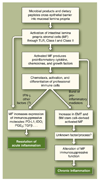Intestinal mesenchymal cells
- PMID: 20690004
- PMCID: PMC2975955
- DOI: 10.1007/s11894-010-0135-y
Intestinal mesenchymal cells
Abstract
The non-white blood cell mesenchymal elements of the intestinal lamina propria are the myofibroblasts, fibroblasts, pericytes, stromal stem cells, muscularis mucosae, and the smooth muscle of the villus core associated with the lymphatic lacteal. We review the functional anatomy of these mesenchymal cells, what is known about their origin in the embryo and their replacement in adults, their putative role in intestinal mucosal morphogenesis, and the intestinal stem cell niche, and we consider new information about myofibroblasts as nonprofessional immune cells. Although our knowledge of the function of mesenchymal cells in intestinal disease is rudimentary, we briefly consider here their roles in cancer and intestinal inflammation.
Conflict of interest statement
Figures

References
-
-
Andoh A, Bamba S, Brittan M, et al. Role of intestinal subepithelial myofibroblasts in inflammation and regenerative response in the gut. Pharmacol Ther. 2007;114:94–106. This comprehensive review of myofibroblast biology covers the cytokine/chemokine networks, cascades, and receptors expressed by intestinal myofibroblast. The focus on IL-22, IL-23, IL-17, and the proinflammatory cyokines as well as secretion of matrix modifying molecules such as the matrix metalloproteinases (MMPs) and their specific tissue inhibitors (TIMPs) indicate the potential role for these cells in inflamatory bowel disease pathogenesis.
-
-
-
Powell DW, Pinchuk IV, Saada JI, et al. Mesenchymal cells of the intestinal lamina propria. Annu Rev Physiol. 2011 in press. This review is an expanded and more detailed version covering many of the issues discussed briefly in this present Current Gastroenterology Reports article.
-
-
-
Furuya S, Furuya K. Subepithelial fibroblasts in intestinal villi: roles in intercellular communication. Int Rev Cytol. 2007;264:165–223. This is an outstanding review of the anatomy and biology of intestinal myofibroblasts from an entirely different perspective than the information in this Current Gastroenterology Report. This review by the Furuyas deals with, among other aspects, the mechanosensitive properties of myofibroblasts and how they act as a gap junction and adherens junction-connected network, contracting in response to purinergic and endothelial agonists.
-
-
- Adegboyega PA, Mifflin RC, DiMari JF, et al. Immunohistochemical study of myofibroblasts in normal colonic mucosa, hyperplastic polyps, and adenomatous colorectal polyps. Arch Pathol Lab Med. 2002;126:829–836. - PubMed
-
- Powell DW, Adegboyega PA, Di Mari JF, Mifflin RC. Epithelial cells and their neighbors I. Role of intestinal myofibroblasts in development, repair, and cancer. Am J Physiol Gastrointest Liver Physiol. 2005;289:G2–G7. - PubMed
Publication types
MeSH terms
Substances
Grants and funding
LinkOut - more resources
Full Text Sources

